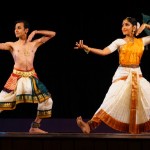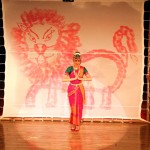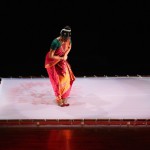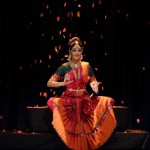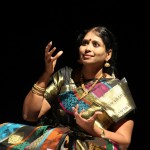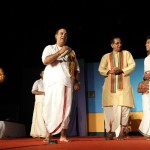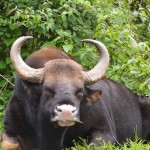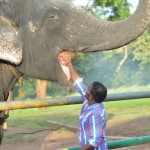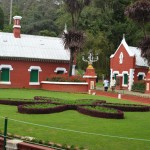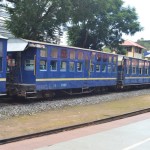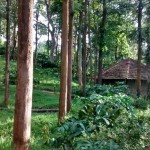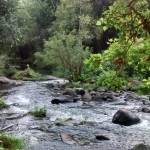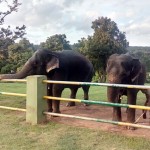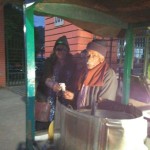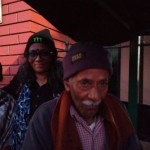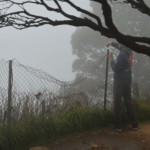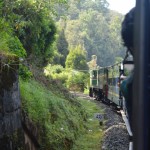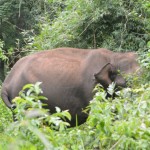Chennai Center stage - by V.V.Ramani
A monthly feature on art events in Chennai – previews and reviews for Art & Deal
Meera - The Soul Divine
Meera the poet princess is an epitome of bhakti and total surrender, and her life story that is so strongly embedded in the minds of Indians , has been a popular theme recurring time and again in Indian folklore ,classical and folk performing arts and visual arts. Swami Dayanandha Saraswathi had a strong desire to throw light on Meerabai during the centenary year celebrations of M.S.Subbhulakshmi ,the great carnatic musician who immortalised the story and music of Meera on celluloid. He was keen that the carnatic vocalist Bombay Jaishri Ramnath design the musical score for a new dance production. Chitra Visweswaran ,the bharatnatyam exponent was then entrusted with the task of giving a visual design by choreographing a dance production. Funded by Aim For Seva, the two artists worked together to present a dance production ‘Meera—The Soul Divine ‘ which was premiered in Chennai recently and has embarked on a tour of U.K and U.S.A.
The nostalgia of M.S’s music is so strongly embedded in the viewers mind , that Jaishri had to work on a musical score which could hold attention .’’The deep thoughts that are embedded in these lyrical gems was great inspiration for me to compose ‘’says Jaishri , who created a melodic score retaining the Bhakthi bhava of the songs with a fine blend of Carnatic and Hindustani ragas ,and her music reached exalted heights in the final segment where Meera unites with her lord Krishna. Chitra ,left with the task of encapsulating the story and the bhakthi element of meera into a short performance duration ,choreographed the narrative to flow smoothly touching upon the salient points .Cleverly ,using four different dancers as Meera ,the transformation from the child ,to the young,then middle aged to the final mature state of total surrender ,the facets of varied stages was portrayed convincingly by the dancers Sahasra,Sruthi Rammohan,Uma Namboodaripad and Chitra Visweswaran ,respectively .The largely narrative style of choreography that was danced by her students culminated with a focus on abhinaya extolling bhakthi bhava danced by Chitra herself .
The lighting design conceptualised by Chitra and handled by Murugan enhanced the mood of the sequences .The costumes that captured the flavour of Rajasthan in its colours could have had a better impact ,had it followed the stylistic patterns of the region , rather than the Bharatnatyam costume style in its design .This production not only highlighted the bhakthi element but also looked at Meera as an inspiring role model , to women who choose the path of their lives.
Simhanandini – the Dancing Lion
A notable aspect of the artistic traditions of India, is the fact that each form of art moves beyond its boundaries , getting inspired or inspiring another art form ,each being enriched by the other. One such art that encompasses visual art and performing art ,is the dancing of ‘Simhanandini ’a dance feature, a unique gem from the archives of the temple traditions in the Kuchipudi dance style , where the dancer sketches the picture of a lion with her feet while dancing on coloured powder .Part of a ritualistic tradition ,this was traditionally performed on Vijayadashami day of the Navarathri festival ,when goddess Kanakadurga is taken on a chariot .The devadasis would sing and dance in praise of Mahishasuramardhini and then draw the picture of a lion to the beat of the Simhanandana tala, the thirthy-seventh tala[and longest one]of the 108 tala system.
Lasya Mavillapalli ,the daughter and disciple of Narasimhacharis, learnt this dance from her mother Vasanthalskshmi and premeired it in Chennai as a tribute to her father Narasimhachari on his first death anniversary .Lasya beginning the performance with a mishra chapu tala composition ‘Narasimham Bhajeham’ composed and choreographed by Vasanthalakshmi in a lively manner,impressed with her depiction of the navarasa ,before proceeding with the dancing lion .Even as her mother was demonstrating the complicated tala pattern ,Lasya stepped on to a white screen stretched on a frame placed over coloured powder.Within one avartana of the Simhanandana tala lasting nearly two minutes ,she was able to sketch with graceful movements ,a picture of the lion with ease .
Vasanthalakshmi ,who had learnt this art from guru C.R.Acharya ,and performed it widely ,felt that this art form needed to be documented and also shared ,so that young dancers and academicians could benefit from it. She re-invented this treasure with guidance from scholars and texts and worked on the music ,tala and choreography to produce a DVD of this dance . This video covers various aspects ranging from its origin and history,codification of talas,a verse on devi ,jathi in simhanandana tala, preparation of a screen used in proscenium stage for the dancer to dance and sketch the lion ,to a final section of a full performance of this dance. Produced by swati soft solutions Sanskriti series ,this DVD priced Rs 650 is a collector’s item for dance enthusiasts. A part of the proceeds from the sale of this DVD will go towards IMPFA[institute of mouth and foot painting artists].
Krishna Bharatham –The Natyarangam Festival .
The problems faced by a multitude of dancers to find a platform for dance ,led to the birth of Natyarangam a dance wing of Naradha Gana Sabha. A group of dedicated committee members with the aim of providing a platform talented young dancers and also to create an enlightened audience base by initiating art appreciation lectures . Besides presenting young talents in their monthly programmes and lectures on related subjects by experts, they have conceptualised an annual dance festival held in august /September which provides young dancers an opportunity to hone their creative skills .
Every year a specific theme is given to the dancers and with an aim to bring in an interdisciplinary approach ,brings together dancers, scholars ,musicians, artists, composers ,poets ,writers and theatre professionals as resource persons to guide .This festival which has become a major event in Chennai’s cultural calendar has successfully completed 20 years, and recently they had their 21st festival titled ‘Krishna Bharatham’ .Krishna ,the darling child was thechosen theme and the dancers explored the various poets and composers of India ,ranging from Alwars to Jayadeva .
The festival honoured Saroja Vaidhyanathan,Bharatnatyam exponent and guru,M.Balachander ,Mridangam artist,Praveen Kumar ,senior Bharatnatyam dancer and Medha Hari ,young Bharatnatyam dancer for promotion of talent .The success of this festival is largely due to the tireless efforts of the committee members Sujatha Vijayaraghavan,K.S.Subramanian,S.Janaki,S.Viswanathan [Charukesi]S,Kannan,Hon.Secrataries,Mohan Sreenivas and K.Harishankar and associates Hyma ,P.C.Ramakrishna and ‘’Aanmajoti’’K.S.Natarajan whose passion for the arts have driven them to continue this honorary work for so many years .
Maniosai – A Musical Opera
Ilango Kumanan,Muralidharan and Anand Krishnan,three enterprising entrepreneurs in the field of outdoor publicity and advertising ,ventured onto the arena of performing arts in April 2012, wanting to promote and nurture talented artistes across all genres and also present star performers in new experimental explorations and creative collaborations to a wider audience base . From classical music and dance, folk arts, western music, fusion music, film music and theatrical shows their company SS International Live ,in a short span of four years have successfully completed their hundredth show ,recently .
Maniosai a musical opera featuring a galaxy of front ranking musicians enacting roles in a play was their hundredth presentation.
Charukesi a writer had worked extensively on tracing the life and musical journey of a genius – Mridangam maestro Palghat Mani Iyer ,interviewing his family members and musicians to come out with a book on this legend. Written in simple tamil this book gives us a complete insight on this artiste.
Based on this book Nityashri Mahadevan, eminent carnatic vocalist and granddaughter of Mani iyer, conceived the idea of giving it a visual dimension in the form of a play .Since the story revolved around many great musicians he had accompanied spanning nearly 70 years of his life ,musicians from the current generation were brought in to enact the varied roles. The singers besides enacting other musicians ,also sang imitating them. With Nityashri donning the role of a Sutradhar-Narrating the story ,the musicians enacted the sequences.
The play worked well in bringing to us an entire lifetime of creative artistes of the past century ,in an encapsulated form in a span of three hours. It is truly commendable that leading musicians came forward to take part in this effort. Some of the artistes got into the skin of the characters with ease , while the others were projecting their own individuality rather than the characters. Audio ,so important for a musical show was below the mark.A lot more care taken in presentation , with attention to aesthetics in costumes , sets and lighting could have added value to a visualization of a great artiste’s life.

